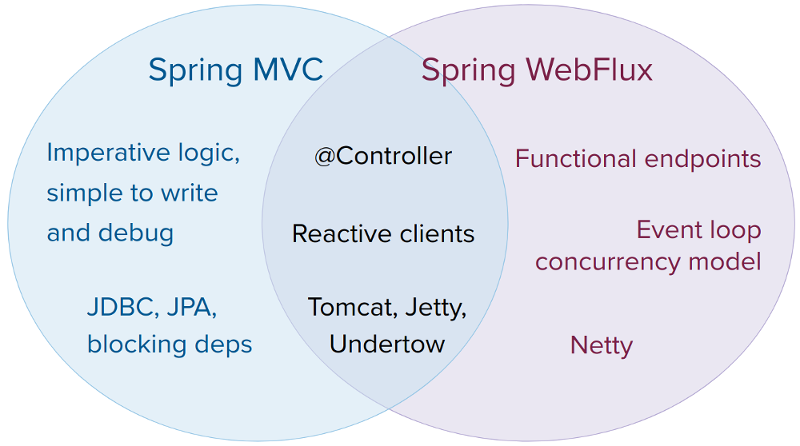SpringBoot 2.0 響應式編程
SpringBoot 2.0 已經發布多時,一直不知道它有什麼用,只是知道它有個webflux。今天就來學習一下,看一下是否有必要升級到新版本?
1 2.0與1.0版本的區別?

- 咱們能夠看出來,增長了些新的特性,主要是對響應式編程的支持,底層多了Netty,這樣就能夠進行非阻塞io的編程,這也是響應式編程的基礎。
- 還有就是2.0對應的java版本必須最低java8,支持java9.若是大家公司使用的仍是1.6,1.7那就不適合升級版本,可能會帶來一堆麻煩。
- 使用webflux並不會提升應用的響應速度,官網也明確指出了。因此不要跟風去使用2.0的版本。
- 使用webflux能夠在有限的資源下提升系統的吞吐量和伸縮性。
2 搭建簡單的webflux項目
若是你是使用得STS來建立項目的話將會很簡單,直接選擇web flux模塊就好。SpringBoot選擇最新穩定的2.1.4.RELEASE。前端
完整pom文件:java
<?xml version="1.0" encoding="UTF-8"?>
<project xmlns="http://maven.apache.org/POM/4.0.0" xmlns:xsi="http://www.w3.org/2001/XMLSchema-instance"
xsi:schemaLocation="http://maven.apache.org/POM/4.0.0 http://maven.apache.org/xsd/maven-4.0.0.xsd">
<modelVersion>4.0.0</modelVersion>
<parent>
<groupId>org.springframework.boot</groupId>
<artifactId>spring-boot-starter-parent</artifactId>
<version>2.1.4.RELEASE</version>
<relativePath/> <!-- lookup parent from repository -->
</parent>
<groupId>com.mike</groupId>
<artifactId>flux</artifactId>
<version>0.0.1-SNAPSHOT</version>
<name>mike-flux</name>
<description>Demo project for Spring Boot</description>
<properties>
<java.version>1.8</java.version>
</properties>
<dependencies>
<dependency>
<groupId>org.springframework.boot</groupId>
<artifactId>spring-boot-starter-webflux</artifactId>
</dependency>
<dependency>
<groupId>org.springframework.boot</groupId>
<artifactId>spring-boot-starter-test</artifactId>
<scope>test</scope>
</dependency>
<dependency>
<groupId>io.projectreactor</groupId>
<artifactId>reactor-test</artifactId>
<scope>test</scope>
</dependency>
</dependencies>
<build>
<plugins>
<plugin>
<groupId>org.springframework.boot</groupId>
<artifactId>spring-boot-maven-plugin</artifactId>
</plugin>
</plugins>
</build>
</project>
建立啓動類:(使用STS會自動建立)react
package com.mike;
import org.springframework.boot.SpringApplication;
import org.springframework.boot.autoconfigure.SpringBootApplication;
@SpringBootApplication
public class MikeFluxApplication {
public static void main(String[] args) {
SpringApplication.run(MikeFluxApplication.class, args);
}
}
3 編寫路由和處理類
有過前端工做經驗的小夥伴,對路由確定不陌生,Vue react中都有統一的路有管理。如今SpringBoot也能夠這樣來寫了。後端的小夥伴能夠把它理解爲你以前寫的controller。
先定義一個處理類:web
package com.mike.handler;
import org.springframework.http.MediaType;
import org.springframework.stereotype.Component;
import org.springframework.web.reactive.function.BodyInserters;
import org.springframework.web.reactive.function.server.ServerRequest;
import org.springframework.web.reactive.function.server.ServerResponse;
import reactor.core.publisher.Mono;
/**
* The class HelloHandler
*
*/
@Component
public class HelloHandler {
public Mono<ServerResponse> sayHello(ServerRequest req) {
return ServerResponse.ok().contentType(MediaType.APPLICATION_JSON_UTF8)
.body(BodyInserters.fromObject(req.queryParam("name").get()));
}
}
Mono定義返回單個結果,定義了響應數據類型以及數據。我是從請求參數中取得name參數進行返回。spring
有了處理類,咱們就須要定義什麼樣的路由交給它來處理,要將路有何處理程序進行mapping:apache
package com.mike.router;
import org.springframework.context.annotation.Bean;
import org.springframework.context.annotation.Configuration;
import org.springframework.http.MediaType;
import org.springframework.web.reactive.function.server.RequestPredicates;
import org.springframework.web.reactive.function.server.RouterFunction;
import org.springframework.web.reactive.function.server.RouterFunctions;
import org.springframework.web.reactive.function.server.ServerResponse;
import com.mike.handler.HelloHandler;
/**
* The class HelloRouter
*
*/
@Configuration
public class HelloRouter {
@Bean
public RouterFunction<ServerResponse> hello(HelloHandler handle){
return RouterFunctions.route(RequestPredicates.GET("/hello")
.and(RequestPredicates.accept(MediaType.APPLICATION_JSON_UTF8))
,handle::sayHello);
}
}
咱們定義了/hello的請求交給咱們的處理類去處理,這樣一次完整的請求就搞定了。啓動程序,訪問http://localhost:8080/hello?name=mike 就能夠看到頁面上的結果了。編程
4 總結
- 和1.0的版本相比,咱們編寫的程序返回結果將由
Mono或Flux來包裹。 - 你能夠選擇使用路由的方式來編寫代碼,而不用寫
controller。 - 異步響應,有時會帶來想不到的麻煩,斷點調試再也不有用。
- 使用webflux 須要根據你本身的項目實際狀況來抉擇。若是你的項目中沒有調用別人的api,就不必使用webflux,用處不大,就像我上面搭建的項目。 若是須要請求別人的api,引入webflux,將會對超時,容錯,失敗重試有很好的改進,使得你的項目更完善,用戶體驗更好。
關於webflux若是你有更深的理解,但願能夠回覆一塊兒交流。後端
若是想要學習更多知識,能夠關注下個人公衆號: api
api
相關文章
- 1. 【SpringBoot】SpringBoot2.0響應式編程
- 2. SpringBoot 2.x (14):WebFlux響應式編程
- 3. spring5響應式編程
- 4. 響應式編程
- 5. 學習響應式編程 Reactor (1) - 響應式編程
- 6. Spring 5 響應式編程
- 7. 響應式編程解析
- 8. Rx響應式編程
- 9. angular2響應式編程流
- 10. 響應式編程總覽
- 更多相關文章...
- • 如何僞造ARP響應? - TCP/IP教程
- • HTTP 響應頭信息 - HTTP 教程
- • IDEA下SpringBoot工程配置文件沒有提示
- • 委託模式
相關標籤/搜索
每日一句
-
每一个你不满意的现在,都有一个你没有努力的曾经。
最新文章
- 1. eclipse設置粘貼字符串自動轉義
- 2. android客戶端學習-啓動模擬器異常Emulator: failed to initialize HAX: Invalid argument
- 3. android.view.InflateException: class com.jpardogo.listbuddies.lib.views.ListBuddiesLayout問題
- 4. MYSQL8.0數據庫恢復 MYSQL8.0ibd數據恢復 MYSQL8.0恢復數據庫
- 5. 你本是一個肉體,是什麼驅使你前行【1】
- 6. 2018.04.30
- 7. 2018.04.30
- 8. 你本是一個肉體,是什麼驅使你前行【3】
- 9. 你本是一個肉體,是什麼驅使你前行【2】
- 10. 【資訊】LocalBitcoins達到每週交易比特幣的7年低點
歡迎關注本站公眾號,獲取更多信息

相關文章
- 1. 【SpringBoot】SpringBoot2.0響應式編程
- 2. SpringBoot 2.x (14):WebFlux響應式編程
- 3. spring5響應式編程
- 4. 響應式編程
- 5. 學習響應式編程 Reactor (1) - 響應式編程
- 6. Spring 5 響應式編程
- 7. 響應式編程解析
- 8. Rx響應式編程
- 9. angular2響應式編程流
- 10. 響應式編程總覽